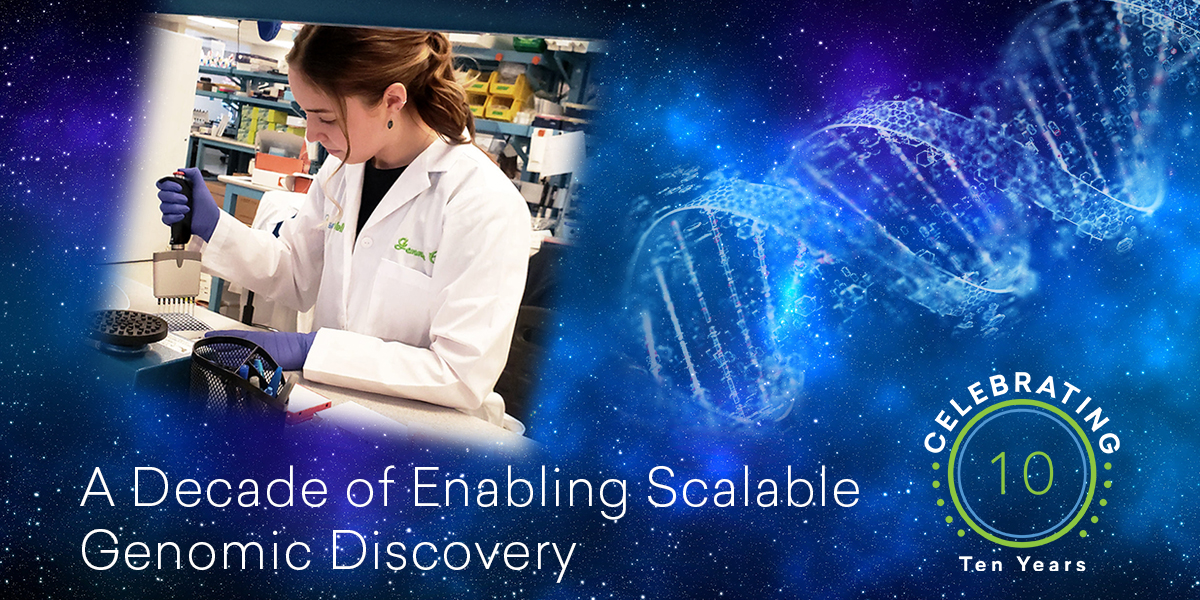
Last month seqWell celebrated ten years since our founding…a decade of our dedicated team of “seqWellians” working diligently to bring a clear vision to life: pioneering innovations that enable every life scientist to unlock transformative discoveries using sequencing. From day one, we have single-mindedly attacked sequencing workflow bottlenecks to unleash the power of NGS across an evolving landscape of applications and platforms.
Looking back over the last ten years, our work at seqWell in many ways has responded to seismic shifts in how sequencing is done. Foremost, an exponential rise in sequencing as a dominant mode for life science research has created an explosion of new applications. Sequencing today is far less centralized in only dedicated labs with the budgets and expertise needed to operate large expensive production sequencing instruments. The rise of benchtop sequencing instruments has put the power of NGS directly in scientists’ hands; at the same time, the cost of production-level sequence data has dramatically dropped, opening new opportunities to utilize sequencing as a primary way to measure biology and health.
Amid these trends, it makes sense that as more labs across the globe deploy NGS assays for a great number of scientific problems, the demand for scalable NGS library construction methods have only increased. Scientists increasingly try to tackle complex questions in basic and applied biology with hundreds or thousands of samples at a time, giving rise to an ever-increasing ‘library prep bottleneck’.
From our earliest days in 2014, seqWell has sought to ease this bottleneck through multiplexing workflow technologies to allow large numbers of samples to be combined into a single library and sequenced together as efficiently as possible. Our first product, plexWell™, released in 2016, changed the paradigm of NGS multiplexing from “prep, then pool” to “pool, then prep” – a time-saving innovation that allowed for processing of hundreds or thousands of samples in a single day. We have continued that theme of innovation with a growing family of transposase-based multiplexing products that are designed to address the unique needs of multiplexing samples in different application areas.
At the core of these technologies sits the remarkable transposase enzyme — a molecular swiss-army knife that adapts DNA molecules into sequencer-ready fragments of various sizes, attaching a wide range of different potential barcoded adapters in a single step. Indexing transposition has allowed seqWell to create a versatile range of multiplexing products to barcode, normalize and pool large numbers of samples in a single NGS library. These capabilities have streamlined a range of applications, including microbial WGS, low-pass human/plant/animal WGS and synthetic construct sequencing.
Fast forwarding to today, our growing team of seqWellians continues to advance these technologies far beyond our initial dream, developing a versatile portfolio of transposase-based library tools to further expand our impact on life science research:
- In areas such as synthetic biology, with production scale needs in synthetic construct screening for downstream applications ranging from gene editing, protein and antibody engineering, the highly simplified ExpressPlex™ product allows for normalized NGS library generation in a single-step reaction in 90 minutes, allowing for highly efficient multiplexing of over 6000 samples in a single day.
- For sensitive applications requiring unique-dual indices, purePlex™ technology allows for normalized library generation with UDI indexing in a simple, automatable workflow that can be run on a variety of short-read NGS instruments.
- Our recently announced LongPlex™ technology brings the capability for indexed transposition to long-read workflows, allowing for multi-kilobase fragmentation and indexing for long-read assays such as hybrid-capture targeted sequencing, and microbial and metagenomic WGS.
- Assays for genome editing QC such as UDiTaS™ and TTIS-seq have been enabled with Tagify™ UMI indexed transposition reagents, that allow for sensitive detection and counting of on- and off-target effects in therapeutic genome engineering research.
While we advance these platform capabilities, we are also harnessing the power of protein engineering to further improve the enzymatic core of our workflow technologies. With the recently announced creation of a newly engineered transposase – TnX™ – seqWell is poised to turbo charge the performance of library prep tools and products with improvements in activity and bias that will open new applications and possibilities, opening doors of performance for the most challenging workflows.
After a decade of pursuing a vision to help solve the workflow challenges and bottlenecks of NGS, we remain as focused and dedicated as ever to helping the scientific community achieve breakthroughs with sequencing. seqWell products have helped deliver the promise of population-scale genomics to new areas of life science reseach and have impacted almost every aspect of human health from transplant biology and infectious diseases, to the development of novel therapeutics and vaccines.
As we turn the page to a new decade, we can’t wait to learn more from you and join you on your journey to discover more with sequencing. Sequence well, friends!
